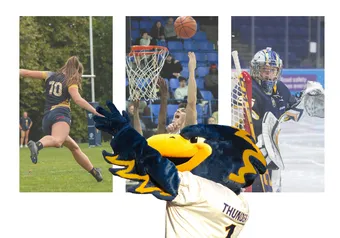“Car racing is the least understood sport on the planet,” said Dr. Andre Marziali.
Dr. Marziali is the director of engineering physics at UBC. On January 17, he gave a lecture about the physics of racing to a packed house in the Earth and Ocean Sciences Building.
There, he explained that competitive car racing is much more complicated than the car’s top speed.
“How fast [your car goes] is not the question … ultimate speed is not racing. Racing is ultimately about timing and control, technological development, taking a machine and pushing it to its absolute limits.”
Professional racecar drivers must be able to control their cars from 250km/h straightaways to hairpin turns within a margin of error of just a few inches. In order to maintain speed through a turn, a driver has to switch from the gas pedal to the brake pedal in less time than it takes to blink an eye.
“Driving fast around a lap is not about the straight bits,” said Marziali. “Everything happens in the turns.”
Friction between the ground and tires limits the speed at which a racecar driver can take a turn. The stronger the force of friction is between the car and the track, the sharper and faster a driver can turn. To be the fastest racer, a driver has to push the car just shy of its traction limit all while navigating the fastest line through a turn.
“Racing is about that limit of grip but also about being on the right line … you have to achieve both,” explained Marziali.
Drivers are also able to increase the traction of the tires by using the inertia of the car as it slows down for a turn. If you’ve ever been in a car when somebody has slammed on the brakes you know the feeling of leaping forward in your seat. This sudden lurch, called the pitch moment, applies extra pressure on the front wheels which help them stick better to the road. This effect allows the car to take sharper turns at higher speeds. Racecar drivers have to perfectly time this process within a few tenths of a second or risk sliding out.
In addition to being an incredibly talented race car driver, winning races requires a perfectly tuned car.
According to Marziali, the best thing you can possibly do to cut time off your lap is to lighten your car. During his lecture, Marziali talked about tearing his car apart with an angle grinder to shed as much weight as possible. With a light car, your tires don’t have to work as hard to get you around those sharp corners.
Another way to increase your turning potential is to decrease your moment of inertia. Your moment of inertia is a measure of how spread out your mass is from the center of rotation. A good way to understand your moment of inertia is to sit on your desk chair and spin with your arms stretched out. As you bring your arms close to your body you should feel yourself start to spin faster around your chair.
Racecar designers can also decrease the moment of inertia by placing the engine as close to the centre of the car as possible.
Altogether, these elements combine for what is described on the club's event page as, “an exceptionally thrilling sport that combines some of the most advanced technical and scientific development pursued in sport, with highly demanding human requirements, both physical and psychological.”
If you are interested in car racing or want to learn more about the physics of racing, contact the UBC Sports Car Club for more information.
Share this article
First online




